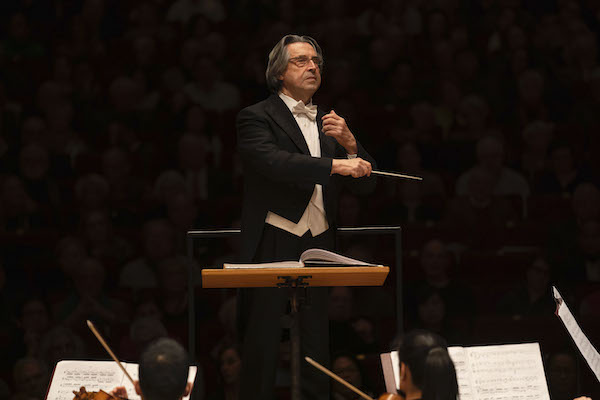Muti, Chicago Symphony mine fresh gold in kaleidoscopic Prokofiev

Old was new and new was old in the Chicago Symphony Orchestra’s all-Prokofiev program led by Riccardo Muti Saturday night in Carnegie Hall.
Is there an older old acquaintance than Prokofiev’s ballet Romeo and Juliet? Excerpts from it have been the accompaniment of choice for dancers, figure skaters, film directors, high-school thespians and probably even elevators. It’s a favorite in concert too; Saturday’s performance by the Chicagoans was the third in a New York hall in less than two months.
But somehow, Muti and his players discovered colors and byways of expression previously overlooked. Who would have thought the familiar score still had so much juice in it?
On the other hand, Prokofiev’s Symphony No. 3 doesn’t get around much, and probably most in the audience knew it, if at all, only by its reputation as one of his most harshly dissonant and forbidding works.
And yet, in Saturday’s performance, except for a few ear-rattling special effects, much of this piece slipped on like an old symphonic shoe, not that far removed from the lush textures and bold drama of Tchaikovsky.
If one were looking for dissonance, one need seek no further than the opening bars of Saturday’s concert, the piercing, hate-filled cluster chords of Romeo and Juliet’s “Montagues and Capulets.” In the heavy-booted march that followed, conductor Muti amped up his orchestra’s exceptionally rich bass foundation till it sounded simultaneously grand and thuggish.
The weightless running violins and tender clarinet solo of “Juliet the Young Girl” could hardly have struck a greater contrast. Here as elsewhere in the piece, Muti set a lively tempo without driving his orchestra faster than dancers could dance.
The popularity of Romeo and Juliet prompted the composer to extract a suite from it for concert performance, then go back later for two more suites. Conductors typically select movements from the three suites and order them for effectiveness in performance rather than story continuity, often ending with the powerful final crescendo of “Death of Tybalt.”
Muti, however, was following the dramatic arc of the play, and so party music was next up, with “Madrigal,” “Minuet,” and “Masks” offering a broad palette of woodwind and string colors, expertly mixed.
Ballroom flirtation led to passion in “Romeo and Juliet,” beginning amid a transparent, layered texture of murmuring bass, pulsing winds and tender high violins, then swelling to an oceanic surge with dazzling piccolo highlights, befitting a love story for the ages.
Tybalt died where he was supposed to, in the middle of the action, providing the drama’s turning point amid fearsomely clanging chords and whooping horns. Ominously, the same beat then underlay the benign ministrations of “Friar Lawrence,” the unwitting agent of the lovers’ fate.
The closing movements, “Romeo and Juliet Before Parting” and “Romeo at Juliet’s Tomb,” brought passion remembered, the ache of loss, and sudden spurts of anger and despair, all evoked by Muti and the musicians with an exquisite ear for emotional color and nuance (the only distraction being a few too many cracked horn notes). Under Muti’s direction, one was aware less of a suite of excerpts than of a drama in a single arc.
Although it too originated in a stage work, Prokofiev’s Third Symphony had a different arc, that of a classical symphony in four movements. The composer, having worked for years on his opera The Fiery Angel, and despairing of ever getting it produced, found symphonic potential in some of its themes and developments. By his own account, conversion to a symphony came easily.
Prokofiev’s opera about a nun’s mystical vision that became an earthly love story had drama to spare, and Muti did not miss a beat of it in the symphonic version. Overseeing it all, both in the bold orchestral colors and passionate crescendos, was the godfather of inner-drama-as-symphony, Tchaikovsky.
On his U.S. tours in the 1920s, while working sporadically on The Fiery Angel, Prokofiev was wooed by Hollywood studios. Hearing his Third Symphony, it wouldn’t be hard to imagine him taking a place alongside Korngold, Steiner and the other émigré film-score masters of the 1930s, particularly in movies on the fantastic or noirish side, where dissonance wasn’t just tolerated, but a necessity.
For example, the mad clangor of bells and strings that opened the Third may have been an unorthodox way to begin a symphony, but it would have been just the thing to open a film about a nun’s turbulent spiritual life.
The piece got down to symphonic business after that, introducing and then developing an abundance of contrasting themes during a lengthy first movement. Alert to the color and character of every moment, Muti kept the whole brew bubbling down to the final fade, pianissimo.
In the Andante, a chanting woodwind chorus and a luminescent chemistry of flutes and muted strings brought thoughts of Tchaikovsky and Firebird, but gently dissonant clashes gave it all a weird feeling, like walking through a garden of strange visions.
In the scherzo, Allegro agitato, ghostly scurrying in the violins was punctuated by timpani and brass thunderclaps. A more legato trio began modestly in the winds but swelled to an all-out Romantic tutti.
The concise but eventful finale launched at near-peak volume with roaring timpani and thumping bass drum, but pulled back to creamy woodwind tones over low strings and eventually a relaxed interlude with a layered texture of strings, winds, and brass. Then chugging rhythms drove the piece to its gratifyingly dissonant conclusion.
The Fiery Angel was never staged during Prokofiev’s lifetime. After a partial performance in concert in 1927, the onetime bad-boy composer was shocked to learn the audience didn’t consider his opera “modern” enough. On Saturday, Muti and the Chicagoans made sure it was dramatic enough, and then some.
Carnegie Hall presents the Boston Symphony Orchestra conducted by Andris Nelsons, with pianist Leif Ove Andsnes and soprano Genia Kühmeier, in works by Grieg and Mahler, 8 p.m. Monday. carnegiehall.org; 212-247-7800.

Posted Nov 18, 2019 at 12:27 pm by Jeffrey Knorr
The Chicago Symphony Orchestra sounds as good/great as I’ve
ever heard them, my having been part of their NY audience since
Jean Martinon. That Maestro Muti has accomplished this despite
having had to fill 6 principal positions recently, the last 3 only
playing Carnegie for the very first time constitutes a minor miracle.
The work ethic and attendant corporate cohesiveness of this
orchestra is remarkable.